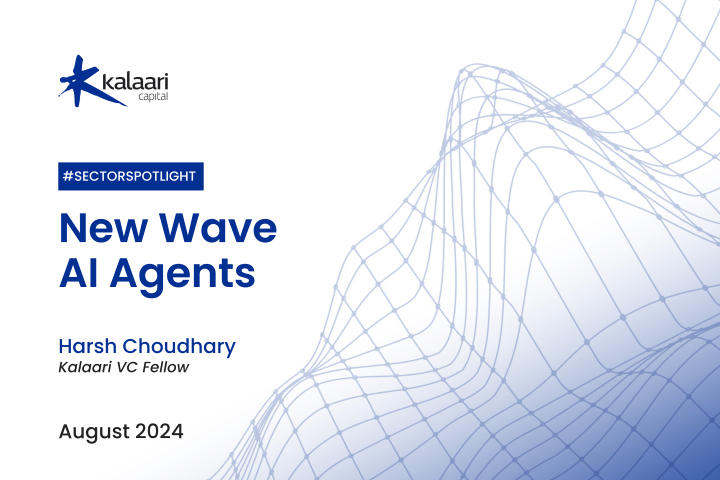In a world where technology is advancing at lightning speed, AI is driving a profound transformation. From everyday tools to systems quietly running in the background, AI is becoming increasingly integral to our lives.
At the core of this transformation is the rise of AI agents—autonomous systems that think, learn, and act independently. These digital entities go beyond responding to commands; they make decisions, solve problems, and even anticipate our needs. Recently, AI products like Cognition AI’s “AI software engineer Devin,” Hume AI’s emotionally intelligent voice model EVI, Synthesia’s AI avatars, and over 80 AI assistant startups funded by Y-Combinator have marked a shift from simple chatbots to human-like agents. Understanding how these AI agents work and what they’re capable of is essential to envisioning the future they’ll shape.
The Promise of AI Agents
Imagine this: It’s Monday morning, and you’re running late for work. You need to:
- Book a cab.
- Adjust your 9 AM meeting based on traffic and notify attendees.
- Order your favorite salad to arrive just as you reach the office.
Instead of juggling multiple apps, imagine simply asking Siri to handle everything in one seamless command. While today’s virtual assistants might manage some of these tasks individually, they lack the capability to execute them in a unified flow. This level of convenience is what AI agents promise in the near future.
The GenAI Metamorphosis
Over recent years, large language models (LLMs) have evolved from simple “stochastic parrots” i.e next-word predictors to powerful tools capable of generating text, creating images, performing calculations, and even writing code. However, AI agents go a step further—they don’t just provide instructions; they can execute multi-step actions autonomously.
What Are AI Agents?
Think of AI agents as smart programs that, when given a goal, can understand context, adapt to their environment, and prioritize tasks to achieve that goal with minimal human oversight. In simple terms, they’re like bots that autonomously complete tasks.
AI Agents vs. Robotic Process Automation (RPA)
While RPA has enabled automation for years, AI agents offer a new level of dynamism:
- Dynamic Planning: Unlike RPA, which follows predefined steps, AI agents can autonomously plan and adapt to changing circumstances.
- Natural Language Processing: RPA relies on coded algorithms, while AI agents translate natural language prompts into machine-readable code.
- Adaptability: RPA fails when inputs deviate from set parameters, whereas AI agents can adjust and handle variations smoothly.

source: sema4.ai/blog
How AI Agents Work: The Technology Behind the Scenes
With the first wave of Generative AI (GenAI), there was a surge in investments in companies developing foundation models and their initial applications for both public and private (enterprise) use. These included fine-tuned models and APIs designed for specific tasks like chatbots and text generation, with or without access to proprietary data for model fine-tuning and execution. However, these early models are “monolithic,” in functionality lacking flexibility.
AI Agents, with the help of their reasoning and planning capabilities, have the potential to tie these Use-cases together with workflows.
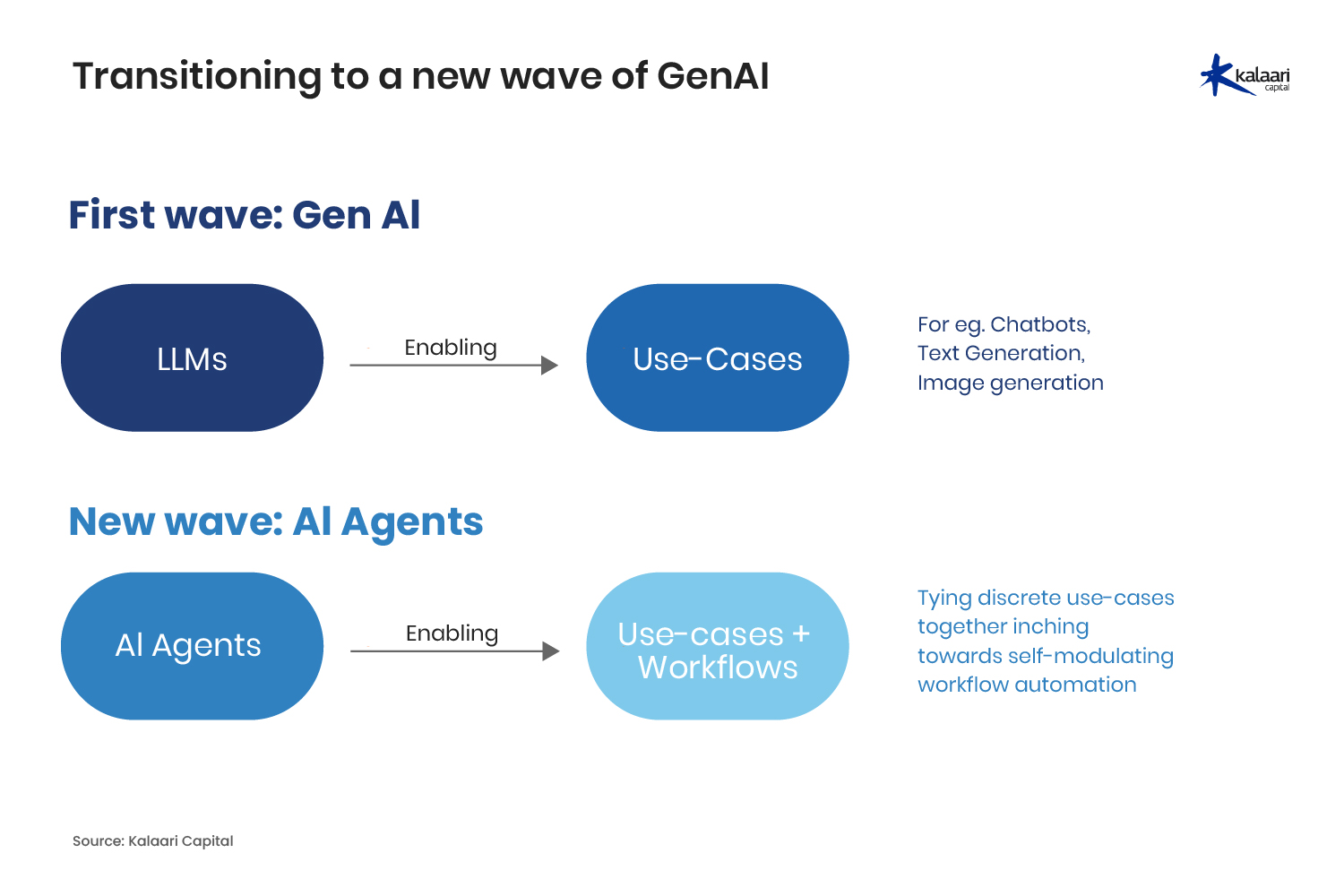
The way these “monolithic” systems are evolving into compound AI systems is by integrating multiple other elements with one or more LLMs (Large Language Models). Beyond just generative functions, these AI agents combine various capabilities to achieve higher levels of functional automation as shown below:

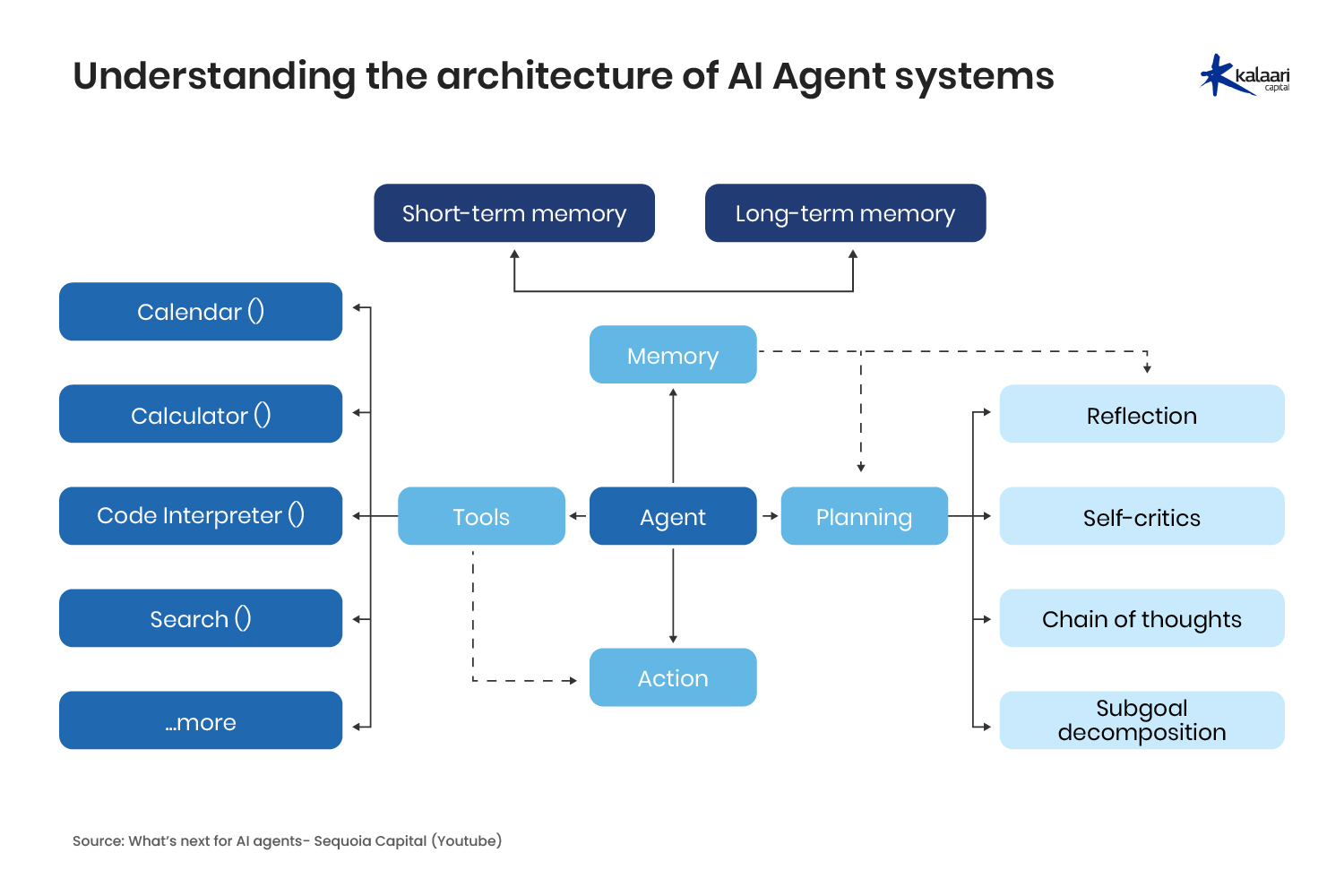
To make this even clearer, let’s take a closer look at one of the tasks mentioned above-
“Push that 9AM meeting by some time depending on the traffic and inform the meeting attendees”
For this command, the AI agent might plan the task execution like how a human would:

As AI agents continue to evolve, deeper integration with the surrounding technology stack and enhanced “agentic frameworks” will drive their maturation and capabilities.
The Opportunity Landscape: Emerging Trends and Applications in AI Agents
AI agents offer transformative benefits such as cost reduction, faster turnaround times, and improved efficiency, making them invaluable for enterprises. This impact is already visible—Klarna’s AI Assistant handled two-thirds of customer support chats within a month, potentially driving a $40 million profit improvement in 2024. Similarly, Dukaan reported an 85% reduction in customer support costs through its AI bot.
Here are a few emerging trends in this space:
1. Reconfiguration of Job Roles:
Like previous technological shifts, AI agents will reshape job roles across industries. Consider a hypothetical data analyst responsible for tracking and reporting data operations performance. Their typical workflow involves tasks like fetching data, cleaning it, analyzing insights, visualizing findings, and reporting observations. With AI agents, many of these repetitive tasks can be automated, simplifying the analyst’s role into two main workflows:
- Process Execution: Handled by AI agents with or without employee supervision.
- Output Review: Conducted by the employee.

The employee’s role transitions from being an “end-output creator” to an “end-output auditor,” leading to:
- Reduced Headcount: Fewer employees required.
- Increased Efficiency: Operational throughput improves, speeding up output cycles.
This shift lowers costs while expanding output capacity, driving demand for labor in this newly defined role.
2. AI-Native SaaS:
AI agents are set to transform human-computer interactions, ushering in a new era of AI-native SaaS, where AI is deeply integrated into software architecture. This shift will produce software with AI at the core of both the user interface (UI) and user experience (UX), potentially moving from traditional graphical user interfaces (GUIs) to conversational user interfaces (CUIs).
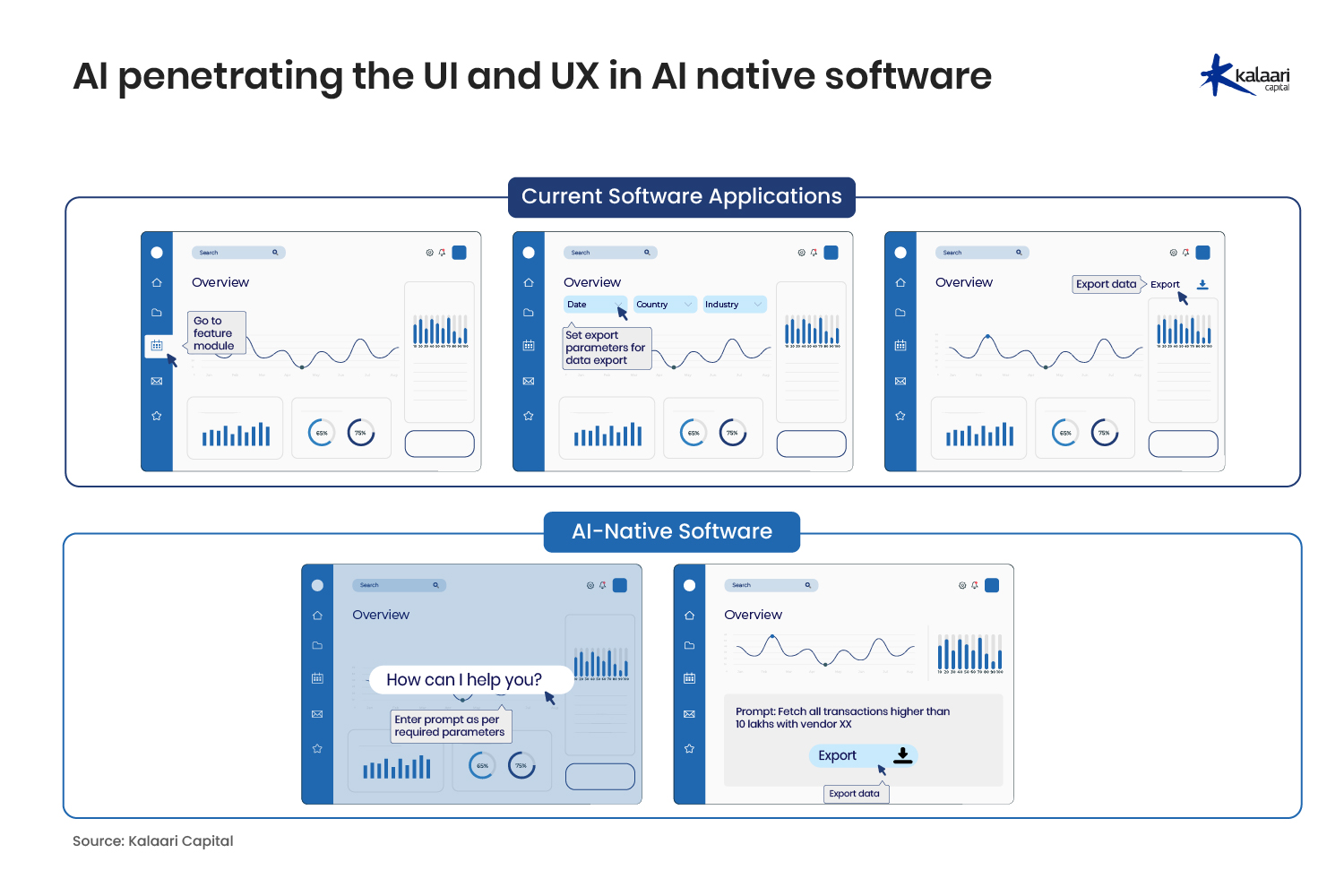
3. Service as a Software:
For a long time ‘Enterprises’ have been people-centric organizations with human capital either in-house or outsourced being essential to achieve business outcomes. Eventually, technology became a performance booster that increased labor productivity. Then came SaaS bringing with it the wave of productization birthing a new model of technology delivery. However, at its core, enterprises want end-solutions that drive business objectives instead of a tool (A SaaS product) that helps them produce that end-solution shifting the value proposition from promise to performance.
As SaaS has grown, a few issues have come to light:
- Subscription Fatigue: Big companies are feeling the pinch from rising software spending.
- Feature redundancy: Many enterprises have multiple SaaS subscriptions for use-cases like Team Collaboration, Project management, Digital analytics that have redundant features for which enterprises must pay for each product separately.
- ROI Woes: The return on investment for SaaS can vary a lot depending on the size and industry of the company.
While AI agents won’t take over overnight, we can expect developments like:
- AI Copilots: Tools that enhance productivity.
- AI-Powered Service Companies: Businesses where AI handles significant workloads with human support.
Overall, this evolution will help automate many manual workflows. Here’s how the AI agent landscape is shaping up:
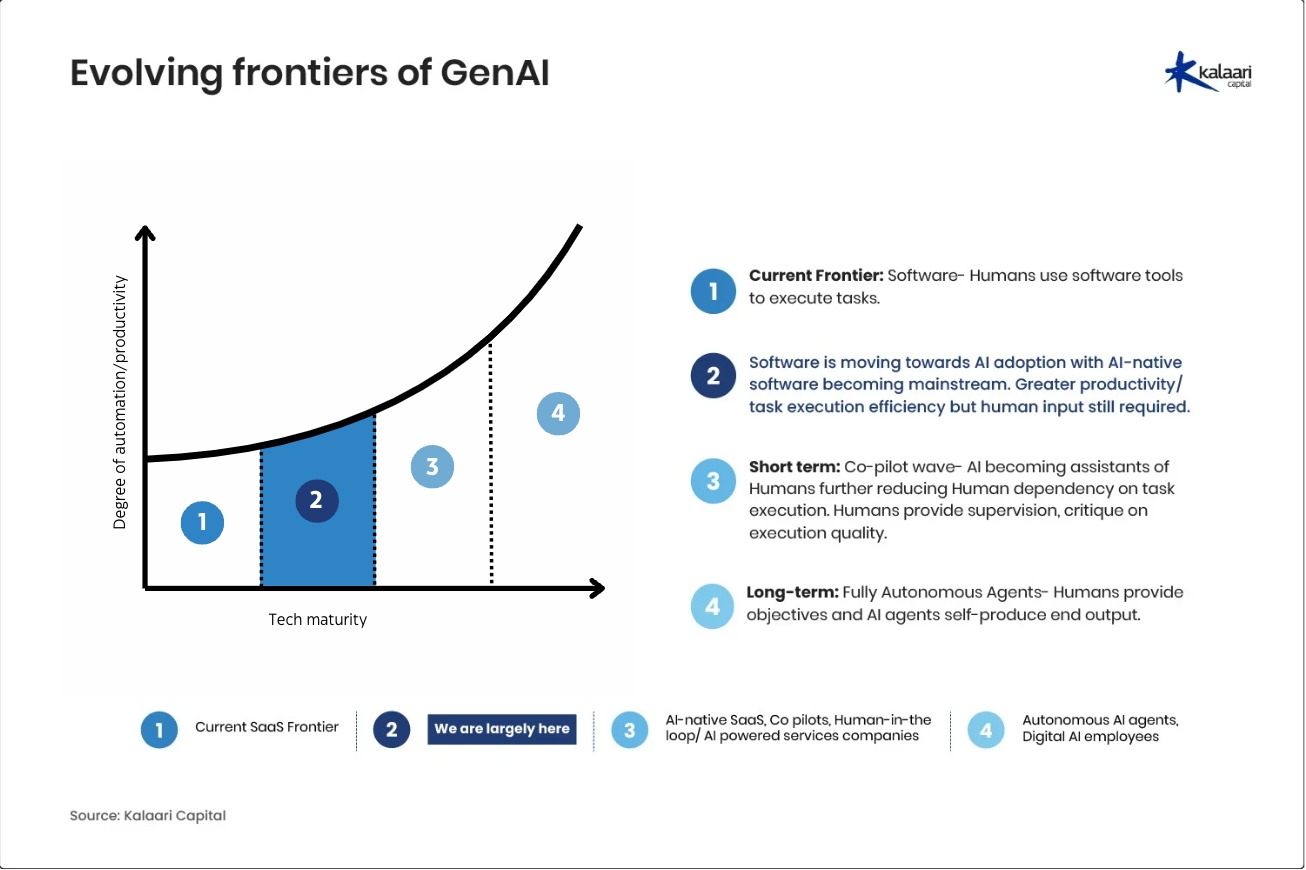
Emerging Applications of AI Agents:
- Business Management Software: From ERPs to CRMs, AI agents have the potential to reimagine these foundational systems by reducing repetitive tasks and manual touchpoints.
- Horizontal vs. Vertical AI Agents: AI products can focus on specific business functions like sales and customer support or target vertical industries such as radiology, enhancing efficiency with specialized AI-driven workflows.
- Enterprise Integration: AI agents can streamline data integration, reduce turnaround time, and automate manual processes, creating a seamless layer of truth in data-driven operations.
- Service-as-a-Software: With the global services market far exceeding the SaaS market, AI agents offer a unique opportunity in areas like customer support, cloud migration, and quality assurance, where they are poised for early adoption and can handle much of the workload.
Impact on pricing
As technology continues to mature and improves its ability to understand process logic, we’re likely to see a shift in how the services and SaaS markets operate. Instead of being separate entities, these markets will become more intertwined, focusing on outcomes rather than just tools.
We’re already witnessing this trend, especially with many AI-first application companies adopting usage-based and outcome-based business models. This convergence means that the lines between labor and software are blurring, leading to more flexible pricing structures that reflect the value delivered rather than just the services provided.

India’s AI Landscape
The Indian startup ecosystem is quickly embracing this wave, with companies developing AI co-pilots and virtual AI employees across various product archetypes.

Conclusion
While there’s a lot of speculation about AI replacing human intelligence, achieving Artificial General Intelligence (AGI) remains a distant goal. For now, the focus should be on how AI will transform work, not replace it. AI agents represent a new wave of innovation, set to redefine human-technology interactions and reshape business operations. Though this transformation won’t happen overnight, the gradual advancements in AI will drive profound changes in enterprise efficiency and market dynamics.
So, buckle up—it’s going to be an exciting journey!
And if you’re a founder working in this space, we’d love to hear from you. Reach out to us at pitch@kalaari.com.







